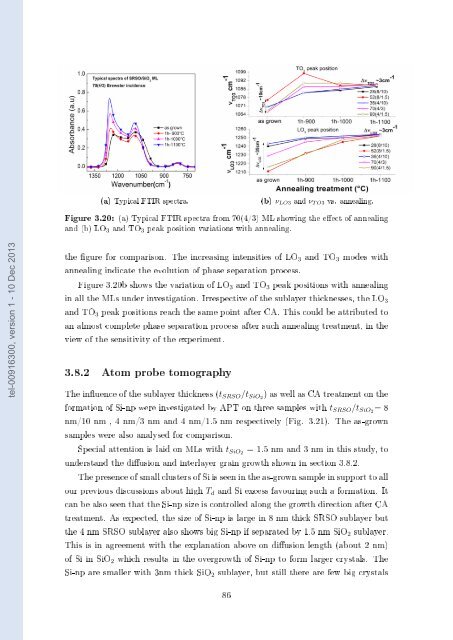Films minces à base de Si nanostructuré pour des cellules ...
Films minces à base de Si nanostructuré pour des cellules ...
Films minces à base de Si nanostructuré pour des cellules ...
You also want an ePaper? Increase the reach of your titles
YUMPU automatically turns print PDFs into web optimized ePapers that Google loves.
(a) Typical FTIR spectra.<br />
(b) ν LO3 and ν T O3 vs. annealing.<br />
Figure 3.20: (a) Typical FTIR spectra from 70(4/3) ML showing the eect of annealing<br />
and (b) LO 3 and TO 3 peak position variations with annealing.<br />
tel-00916300, version 1 - 10 Dec 2013<br />
the gure for comparison. The increasing intensities of LO 3 and TO 3 mo<strong>de</strong>s with<br />
annealing indicate the evolution of phase separation process.<br />
Figure 3.20b shows the variation of LO 3 and TO 3 peak positions with annealing<br />
in all the MLs un<strong>de</strong>r investigation. Irrespective of the sublayer thicknesses, the LO 3<br />
and TO 3 peak positions reach the same point after CA. This could be attributed to<br />
an almost complete phase separation process after such annealing treatment, in the<br />
view of the sensitivity of the experiment.<br />
3.8.2 Atom probe tomography<br />
The inuence of the sublayer thickness (t SRSO /t <strong>Si</strong>O2 ) as well as CA treatment on the<br />
formation of <strong>Si</strong>-np were investigated by APT on three samples with t SRSO /t <strong>Si</strong>O2 = 8<br />
nm/10 nm , 4 nm/3 nm and 4 nm/1.5 nm respectively (Fig. 3.21). The as-grown<br />
samples were also analysed for comparison.<br />
Special attention is laid on MLs with t <strong>Si</strong>O2 = 1.5 nm and 3 nm in this study, to<br />
un<strong>de</strong>rstand the diusion and interlayer grain growth shown in section 3.8.2.<br />
The presence of small clusters of <strong>Si</strong> is seen in the as-grown sample in support to all<br />
our previous discussions about high T d and <strong>Si</strong> excess favouring such a formation. It<br />
can be also seen that the <strong>Si</strong>-np size is controlled along the growth direction after CA<br />
treatment. As expected, the size of <strong>Si</strong>-np is large in 8 nm thick SRSO sublayer but<br />
the 4 nm SRSO sublayer also shows big <strong>Si</strong>-np if separated by 1.5 nm <strong>Si</strong>O 2 sublayer.<br />
This is in agreement with the explanation above on diusion length (about 2 nm)<br />
of <strong>Si</strong> in <strong>Si</strong>O 2 which results in the overgrowth of <strong>Si</strong>-np to form larger crystals. The<br />
<strong>Si</strong>-np are smaller with 3nm thick <strong>Si</strong>O 2 sublayer, but still there are few big crystals<br />
86
















